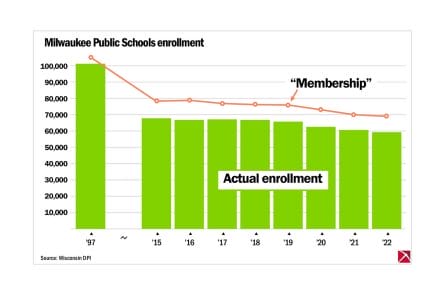This post originally appeared at https://www.badgerinstitute.org/mps-enrollment-often-overstated-has-plummeted-42-since-peak/
District asking voters to approve another $252 million annually
Enrollment in schools run by Milwaukee Public Schools district is now down to 59,200 — a dramatic and larger decline than is often acknowledged in a district that is asking its voters for $252 million more a year in funding in an April 2 referendum.
That’s a 42% drop, one of more than 42,000 students, since the peak in 1997-98, when the district had 101,300 students enrolled.

Supporters of the district often allude to a different, higher, “membership” figure in the district: 68,000 – down from a peak of about 105,000 “members” in 1997-98.
Membership figures can be misleading, though, because they include students in charter schools that are authorized by MPS but not controlled by it.
The district’s decline in enrollment has come as both the number of children in Milwaukee has fallen — by about 8% from 1997’s 151,000 to 2022’s 139,000 — and as other schooling options have blossomed in the city.
In 1997-98, about 1,500 Milwaukee students took their state aid to one of 23 private schools under Wisconsin’s parental choice program, while in 2022-23, about 29,000 Milwaukee students were using the program to attend 129 private schools.
Public charter school enrollment has also expanded since the 1990s — a key fact when differentiating between “enrollment” and so-called “membership.”
Charter schools in Wisconsin can be authorized by school districts, and can be either “instrumentality” schools, staffed by a district’s employees and with students that count as district students, or “non-instrumentality” schools staffed and run by outside organizations. Some charter schools, called “independent,” are authorized by other governments, universities or the state, and are entirely separate from school districts.
MPS authorizes 19 charter schools this year, according to state figures, of which 11 are staffed by the district, enrolling about 1,900 students. The eight charters authorized by MPS but run and staffed by outside organizations enroll about 7,600 students this year.
But all of these students are included by the DPI when it calculates the district’s “membership,” the figure it uses in calculating state aid, revenue limits, and per-pupil spending. The membership figure also includes some other students, such as those using public school open enrollment to attend a district other than the one they live in. MPS last year on net lost about 3,200 students to other districts through that program.
It’s unclear how the use of membership figures rather than enrollment figures might throw off the key calculation of per-pupil funding.
According to the DPI’s most recent figures, for the 2021-22 school year, MPS spent $18,035 per “member” in “total education cost” — that is, spending on education, transporting children, and maintaining its facilities — up from an inflation-adjusted $10,663 in 1999, the earliest year for which comparable figures are readily available from the DPI.
DPI finance staff were unavailable for comment this week.
MPS is one of about 100 districts in Wisconsin this year to ask voters to approve an increase in its revenue limit, the cap on how much money the district can collect between property taxes and state aid.
The additional money, leading to a $367 increase in taxes on a median-priced $170,000 home, is needed, the district says, because state aid hasn’t kept up with its needs. Critics have faulted the district for failing to plan for its falling enrollment — leaving many of its school buildings dramatically underused — and for not explaining how it would use additional money to improve teaching performance.
Patrick McIlheran is the Director of Policy at the Badger Institute. Permission to reprint is granted as long as the author and Badger Institute are properly cited.
Submit a comment
“*” indicates required fields
/* = 0;if(!is_postback){return;}var form_content = jQuery(this).contents().find(‘#gform_wrapper_21’);var is_confirmation = jQuery(this).contents().find(‘#gform_confirmation_wrapper_21’).length > 0;var is_redirect = contents.indexOf(‘gformRedirect(){‘) >= 0;var is_form = form_content.length > 0 && ! is_redirect && ! is_confirmation;var mt = parseInt(jQuery(‘html’).css(‘margin-top’), 10) + parseInt(jQuery(‘body’).css(‘margin-top’), 10) + 100;if(is_form){jQuery(‘#gform_wrapper_21’).html(form_content.html());if(form_content.hasClass(‘gform_validation_error’)){jQuery(‘#gform_wrapper_21’).addClass(‘gform_validation_error’);} else {jQuery(‘#gform_wrapper_21’).removeClass(‘gform_validation_error’);}setTimeout( function() { /* delay the scroll by 50 milliseconds to fix a bug in chrome */ jQuery(document).scrollTop(jQuery(‘#gform_wrapper_21’).offset().top – mt); }, 50 );if(window[‘gformInitDatepicker’]) {gformInitDatepicker();}if(window[‘gformInitPriceFields’]) {gformInitPriceFields();}var current_page = jQuery(‘#gform_source_page_number_21’).val();gformInitSpinner( 21, ‘https://e74sq7k37a8.exactdn.com/wp-content/plugins/gravityforms/images/spinner.svg’, true );jQuery(document).trigger(‘gform_page_loaded’, [21, current_page]);window[‘gf_submitting_21’] = false;}else if(!is_redirect){var confirmation_content = jQuery(this).contents().find(‘.GF_AJAX_POSTBACK’).html();if(!confirmation_content){confirmation_content = contents;}setTimeout(function(){jQuery(‘#gform_wrapper_21’).replaceWith(confirmation_content);jQuery(document).scrollTop(jQuery(‘#gf_21’).offset().top – mt);jQuery(document).trigger(‘gform_confirmation_loaded’, [21]);window[‘gf_submitting_21’] = false;wp.a11y.speak(jQuery(‘#gform_confirmation_message_21’).text());}, 50);}else{jQuery(‘#gform_21’).append(contents);if(window[‘gformRedirect’]) {gformRedirect();}} const gformWrapperDiv = document.getElementById( “gform_wrapper_21” ); if ( gformWrapperDiv ) { const visibilitySpan = document.createElement( “span” ); visibilitySpan.id = “gform_visibility_test_21”; gformWrapperDiv.insertAdjacentElement( “afterend”, visibilitySpan ); } const visibilityTestDiv = document.getElementById( “gform_visibility_test_21” ); let postRenderFired = false; function triggerPostRender() { if ( postRenderFired ) { return; } postRenderFired = true; jQuery( document ).trigger( ‘gform_post_render’, [21, current_page] ); gform.utils.trigger( { event: ‘gform/postRender’, native: false, data: { formId: 21, currentPage: current_page } } ); if ( visibilityTestDiv ) { visibilityTestDiv.parentNode.removeChild( visibilityTestDiv ); } } function debounce( func, wait, immediate ) { var timeout; return function() { var context = this, args = arguments; var later = function() { timeout = null; if ( !immediate ) func.apply( context, args ); }; var callNow = immediate && !timeout; clearTimeout( timeout ); timeout = setTimeout( later, wait ); if ( callNow ) func.apply( context, args ); }; } const debouncedTriggerPostRender = debounce( function() { triggerPostRender(); }, 200 ); if ( visibilityTestDiv && visibilityTestDiv.offsetParent === null ) { const observer = new MutationObserver( ( mutations ) => { mutations.forEach( ( mutation ) => { if ( mutation.type === ‘attributes’ && visibilityTestDiv.offsetParent !== null ) { debouncedTriggerPostRender(); observer.disconnect(); } }); }); observer.observe( document.body, { attributes: true, childList: false, subtree: true, attributeFilter: [ ‘style’, ‘class’ ], }); } else { triggerPostRender(); } } );} );
/* ]]> */
The post MPS enrollment, often overstated, has plummeted 42% since peak appeared first on Badger Institute.
